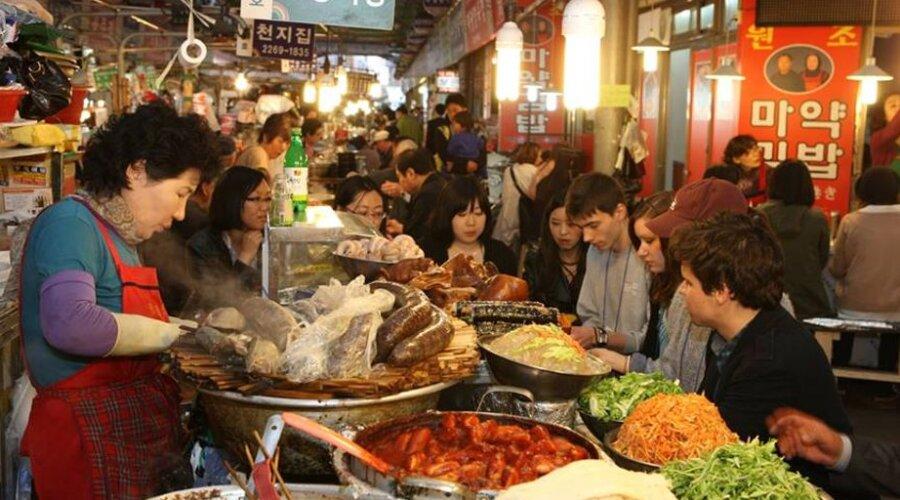“Epicurean Exploration: Gastronomic Adventures Across South Korea”
Embark on a mouthwatering expedition through South Korea’s vibrant culinary landscape. From the bustling streets of Seoul to the traditional markets and regional specialties, this journey will uncover the diverse flavors and innovative dishes that define Korean cuisine. Whether you’re a foodie seeking the thrill of street food or a gourmet enthusiast eager to explore fine dining, South Korea offers a gastronomic adventure like no other.
Key Takeaways
- South Korea’s street food scene, especially in Seoul, is a must-experience for any food lover, featuring iconic dishes like Tteokbokki and Hotteok.
- Traditional markets such as Gwangjang and Namdaemun offer a feast for the senses with a variety of local delicacies and vibrant atmospheres.
- Regional specialties, including Jeonju Bibimbap and Busan’s fresh seafood, highlight the country’s diverse culinary heritage beyond the capital.
- Modern Korean cuisine is a blend of tradition and innovation, with fusion dishes and fine dining experiences in areas like Gangnam.
- Hidden gems, from local favorites in Incheon to Jeju Island’s black pork, provide unique and authentic culinary experiences off the beaten path.
Sizzling Street Food in Seoul

Tteokbokki: Spicy Rice Cakes
When in Seoul, you can’t miss the fiery delight of Tteokbokki. These spicy rice cakes are a staple in the city’s street food scene. Made from chewy rice cakes, fish cakes, and a spicy gochujang sauce, Tteokbokki is a flavor explosion that will leave you craving more. The best places to try this dish are the bustling street food stalls scattered across the city.
Hotteok: Sweet Pancakes
Hotteok is a sweet treat that will satisfy your dessert cravings. These Korean pancakes are filled with a mixture of brown sugar, honey, chopped peanuts, and cinnamon. Cooked on a griddle until golden brown, they are crispy on the outside and gooey on the inside. Perfect for a quick snack while exploring Seoul’s vibrant streets.
Gimbap: Korean Sushi Rolls
Gimbap is often referred to as Korean sushi rolls, but it has its own unique twist. These rolls are made with seasoned rice, various vegetables, and sometimes meat, all wrapped in seaweed. They are a convenient and delicious option for a meal on the go. You can find Gimbap at many street food stalls and markets throughout Seoul.
Immerse yourself in the vibrant streets teeming with delectable treats and discover the culinary marvels of this dynamic city. Let us be your compass as you navigate Seoul’s vibrant flavors, ensuring an unforgettable journey brimming with memorable experiences.
Best Places to Try Street Food in Seoul
- Myeongdong: A bustling shopping district with a wide variety of street food options.
- Gwangjang Market: A gastronomic paradise with traditional Korean street food.
- Dongdaemun Night Market: Perfect for late-night food adventures.
Kickstart your travel exploration online today and prepare to immerse yourself in Seoul’s diverse and delicious street food scene!
Traditional Markets: A Feast for the Senses
Gwangjang Market: A Culinary Wonderland
Gwangjang Market is a culinary wonderland where you can indulge in a feast of delicious Korean food. From savory pancakes to fresh sashimi, the market offers a wide array of traditional dishes that will tantalize your taste buds. Don’t miss out on the famous bindaetteok (mung bean pancakes) and mayak gimbap (mini seaweed rice rolls).
Namdaemun Market: A Foodie’s Paradise
Namdaemun Market is a foodie’s paradise, bustling with energy and aromas that will draw you in. Here, you can find everything from street food to exotic ingredients. The market is particularly famous for its hotteok (sweet pancakes) and kalguksu (hand-cut noodle soup). It’s a place where market spices drifting on a breeze create an unforgettable sensory experience.
Tongin Market: Dosirak Cafe
Tongin Market offers a unique dining experience with its Dosirak Cafe. Visitors can purchase traditional brass coins to buy various dishes from different stalls, creating their own personalized meal. This interactive approach makes it a fun and engaging way to explore Korean cuisine. The market is known for its jeon (Korean pancakes) and tteokbokki (spicy rice cakes).
Discovering hidden culinary gems often means venturing off the beaten path to explore local markets and sample regional specialties. From tangy seafood dishes to hearty stews, each bite can reveal a story of history and tradition, inviting travelers on a delicious adventure through diverse local flavors.
Regional Delicacies: Beyond the Capital
Jeonju Bibimbap: A Rice Bowl Masterpiece
Jeonju is often hailed as the birthplace of bibimbap, a colorful and nutritious rice bowl. This dish is a perfect blend of rice, vegetables, meat, and a spicy gochujang sauce. The city of Jeonju takes pride in its unique version, which often includes raw beef and a raw egg yolk on top. It’s a must-try for anyone visiting South Korea.
Busan’s Fresh Seafood: Jagalchi Market
Busan, South Korea’s second-largest city, is famous for its fresh seafood. The Jagalchi Market is a bustling hub where you can find everything from live octopus to king crabs. The market is a sensory overload, with the sights, sounds, and smells of the ocean. Don’t miss the chance to try hoe (raw fish) or a hearty bowl of seafood stew.
Andong Jjimdak: Braised Chicken Delight
Andong Jjimdak is a savory braised chicken dish that originates from the city of Andong. This dish features chicken, vegetables, and glass noodles simmered in a soy-based sauce. The result is a rich and flavorful meal that’s both comforting and satisfying. It’s a great example of how South Korean cuisine can be both hearty and delicious.
Modern Korean Cuisine: Fusion and Innovation
Korean BBQ with a Twist
Korean BBQ is a staple, but fusion cuisine has taken it to new heights. Imagine the bold flavors of Korean BBQ combined with the convenience of Mexican street food, resulting in mouth-watering Korean BBQ tacos. This delicious amalgamation of flavors and techniques is a testament to how cultures interact and communities merge.
Fine Dining in Gangnam
Gangnam is not just a trendy district; it’s a culinary hotspot. Here, you’ll find restaurants that blend traditional Korean flavors with international techniques. Whether it’s a French-Korean fusion dish or an Italian pasta with a Korean twist, the innovation is endless. The chefs in Gangnam are true artists, creating dishes that are as visually stunning as they are delicious.
Innovative Street Eats
Street food in South Korea is already legendary, but the fusion trend has added an exciting layer. From kimchi quesadillas to bulgogi burgers, the streets are filled with inventive eats that push the boundaries of traditional Korean cuisine. These innovative street eats are perfect for adventurous foodies looking to explore new flavors.
ya!korea – discover korea: where tradition and innovation blend for memorable adventures. explore korean cinema, celebrities, and entertainment industry evolution through articles by sean sul.
Sweet Endings: Desserts and Cafes
Indulging in sweet temptations is an essential part of our culinary journey. From the classics to the contemporary, desserts have the power to transport us to a world of flavors and emotions. So, go ahead and treat yourself!
Bingsu: Shaved Ice Treats
Bingsu is a popular Korean dessert that features finely shaved ice topped with a variety of sweet toppings like red beans, fruits, and condensed milk. It’s a refreshing treat, especially during the hot summer months. One bite of this icy delight and you’ll be hooked!
Korean Bakeries: Breads and Pastries
Korean bakeries are a haven for bread and pastry lovers. From fluffy milk bread to sweet red bean buns, there’s something for everyone. These cafe-restaurants often offer a cozy atmosphere where you can enjoy your treats with a cup of coffee or tea.
Themed Cafes: A Unique Experience
South Korea is famous for its themed cafes, ranging from animal cafes to cartoon-themed spots. These cafes offer more than just food; they provide an experience. Whether you’re petting a cat or sipping coffee in a fairy-tale setting, these cafes are a must-visit for anyone looking to add a bit of whimsy to their day.
Life is too short to resist the allure of sweet temptations. From decadent cakes to creamy puddings, desserts have a way of making our taste buds dance with joy. Indulging in these delightful treats is an essential part of our gastronomic journey, and in this section, we will explore some of the desserts that are guaranteed to satisfy your sweet tooth and leave you craving for more.
Hidden Gems: Off the Beaten Path
While famous restaurants and popular eateries are always a safe bet, don’t be afraid to venture off the beaten path and explore hidden gems. Often, it is in these lesser-known establishments that you will find truly exceptional food. Seek recommendations from locals or trusted food bloggers to discover those hidden culinary treasures that may not be on the usual tourist radar. You might stumble upon a quaint family-run restaurant serving up authentic, mouthwatering dishes that will leave a lasting impression.
Local Favorites in Incheon
Incheon is more than just an airport city. It’s a treasure trove of local favorites that offer a unique culinary experience. From savory seafood dishes to delightful street food, Incheon has it all. Don’t miss out on trying the local specialty, Jajangmyeon, a black bean noodle dish that is both hearty and delicious.
Chuncheon Dakgalbi: Spicy Chicken Stir-fry
Chuncheon is famous for its Dakgalbi, a spicy chicken stir-fry that is cooked right at your table. This dish is perfect for those seeking authentic experiences in South Korea. The combination of marinated chicken, vegetables, and spicy sauce makes for a meal that is both flavorful and satisfying. Pair it with some local Makgeolli, a traditional Korean rice wine, for the full experience.
Jeju Island’s Black Pork
Jeju Island is renowned for its black pork, a delicacy that is a must-try for any meat lover. The pork is known for its tender texture and rich flavor, making it a standout dish. Whether you try it grilled or in a hearty stew, Jeju’s black pork is sure to leave a lasting impression. Make sure to visit a local restaurant to get the most authentic taste of this regional specialty.
Conclusion
Wrapping up our epicurean exploration across South Korea, it’s clear that this country is a paradise for food lovers. From bustling street markets to hidden gourmet gems, every corner of South Korea offers a unique and unforgettable culinary experience. Whether you’re indulging in the savory delights of traditional dishes or discovering innovative fusion creations, the flavors here are bound to leave a lasting impression. So, grab your chopsticks and get ready to embark on your own gastronomic adventure—South Korea’s culinary wonders are waiting for you!
Frequently Asked Questions
What is the best time to visit South Korea for a food tour?
The best time to visit South Korea for a food tour is during the spring (April to June) and autumn (September to November) seasons. The weather is pleasant, and many food festivals take place during these times.
Are there vegetarian options available in Korean cuisine?
Yes, there are several vegetarian options in Korean cuisine, such as bibimbap (without meat), pajeon (vegetable pancakes), and various side dishes like kimchi and pickled vegetables.
What is the most famous street food in Seoul?
One of the most famous street foods in Seoul is Tteokbokki, which are spicy rice cakes. They are widely available in street markets and food stalls across the city.
Can I find international cuisine in South Korea?
Yes, South Korea, especially cities like Seoul and Busan, offers a wide variety of international cuisine. You can find everything from Italian and Mexican to Indian and Middle Eastern food.
Is it necessary to tip in South Korean restaurants?
Tipping is not a common practice in South Korea. Most restaurants include service charges in the bill, and additional tipping is not expected.
What is a must-try dessert in South Korea?
A must-try dessert in South Korea is Bingsu, a shaved ice treat that comes in various flavors and toppings, including fruits, red beans, and condensed milk.



